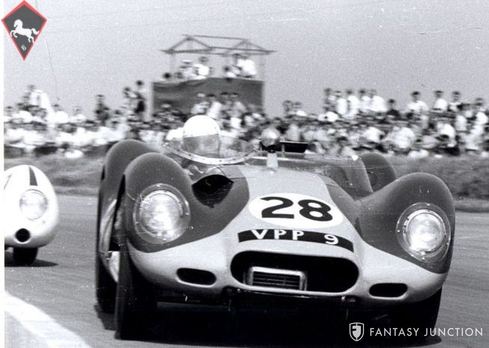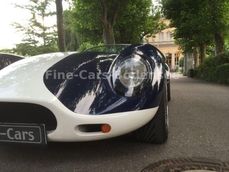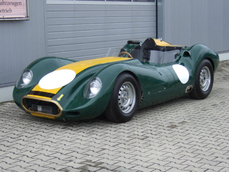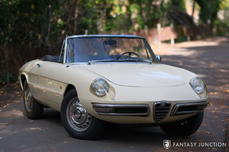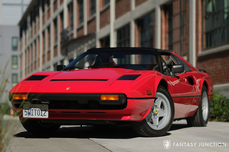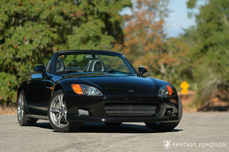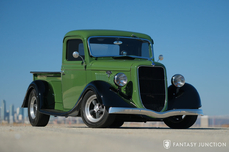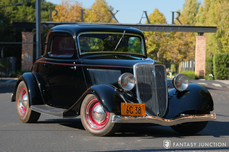Lister -Jaguar 1958
Allmän beskrivning :
1958 Lister-Jaguar “Knobbly”
s/n BHL 119
Dark Blue with Gold Stripe and Black Interior
The “Knobbly” body Lister-Jaguars are in many ways the quintessential postwar British sports car. The result of a plucky and resourceful hybrid approach that was typical for the period, the Listers were remarkably successful from the outset. Brian Lister’s family had been involved in engineering and manufacturing since the late 19th century, and as he came of age in the postwar years, he began racing in the late 40s, and was producing his own cars, initially with MG or Bristol powerplants, by the mid 1950s. In the days where it was still genuinely possible for a small upstart firm to produce truly world-class sports cars, Lister quickly created a name for himself.
As Jaguar was retiring its factory-backed efforts from motorsports in 1956, BP was left without a racing team to back (other British manufacturers ran with Esso primarily), and they approached Lister about picking up where Jaguar was leaving off. They agreed to supply the latest competition-specification Jaguar XK powerplants if Lister would produce a larger car that could contest outright sports car victories to put the engines in. The so-called “Knobbly” body cars were aggressive and assertive where the D-Type had been delicate and graceful. Their unique shape was due to a clever relationship with the regulations, specifically the FIA Appendix J regulations that specified a minimum windscreen height. To reduce frontal area, the cowl of the car was lowered as much as possible aft of the rather tall Jaguar XK powerplant to keep the car’s overall height low. This, coupled with the bulging wheel arches, gave the car its “Knobbly” nickname.
Produced from 1957 to 1959, the cars were quite successful and they became the cars to beat. In fact, a Lister won the SCCA national championship in 1958. Listers are closely associated with Archie Scott-Brown, who despite a deformed right arm, was a talented and sensitive development driver and a very quick racer. He played an integral role in the development of the Listers, and at his hands, the cars were immediately successful. The effectiveness of the cars was not missed by Briggs Cunningham, who bought two, and for the 1958 season, Jim Hall, Carroll Shelby, and Ecurie Ecosse all had them as part of their stables. Brian Lister was severely shaken by Archie Scott-Brown’s death in 1958 at Spa behind the wheel of a Knobbly, and would eventually withdraw from motor racing at the end of the 1959 season, putting what was almost certainly a premature end to the Lister motor racing exploits. Approximately a dozen Jaguar-powered Knobbly Listers were built, and another ten or so cars with Chevrolet power.
The majority of Lister factory records have not survived, so the details about most cars remain unclear. For example, at least three different cars wore the registration number VPP 9, including the car in which Scott-Brown was killed in May of 1958. It was common for the same registration number to appear on more than one car. After Scott-Brown’s crash, it appears that VPP 9 was transferred to this car, which was completed in time to race the Silverstone Grand Prix on the 19th of July 1958. Driven by Walt Hansgen, the car was running second behind Stirling Moss also in a Lister-Jaguar when the clutch failed. The following week, Hansgen won twice at Snetterton in this car, in the unlimited class and the Formula Libre race, setting new lap records both times. Ivor Beub went on to win at Brands Hatch in August and at Snetterton in September.
The car’s complete 1958 race history is as follows:
7/19/1958: Silverstone Grand Prix, Walt Hansgen, car # 28, DNF-Clutch was running in 2nd behind Moss when clutch failed
7/25/1958: Snetterton Vanwall Trophy, unlimited class, Walt Hansgen, car # 75
1st Overall Set new lap record of 1:42.8
7/28/1958: Snetterton Vanwal Trophy, Formula Libra Race, Walt Hansgen, car # 75
1st Overall Set new lap record of 1:42
8/4/1958: Brands Hatch Bank Holiday, Ivor Bueb, 1st
9/7/1958: Snetterton Archie Scott Brown Memorial race, Ivor Bueb, 1st
9/13/1958: Goodwood, Ivor Bueb/Bruce Halford, DNF-Steering
The car was then sold to the United States, where the car appears to have raced in SCCA events, and returned to the United Kingdom in 1970. The car was restored by John May and appeared for its first historic race on the 15th of July 1972, now registered MVE 303. The car was driven by John Harper, who would extensively campaign the car well into the 80s at Silverstone, Le Mans, Brands Hatch and other venues. Paul Skilleter discusses the car at length in his book “Lister-Jaguar” and attended many races with the car’s owner. Skilleter described this car as “the most actively-raced Lister-Jaguar and the most consistently quick…it was the car to beat.”
In the 1980s and 1990s, it belonged to Dr. Philippe Renault then Dietrich von Boetticher, both collectors and enthusiastic racers, and in 1996, it was acquired by Frank Styner, a prominent British historic racer. Styner brought the car to the first Goodwood Revival Meeting in September of 1998 and had much restorative work performed by John Pearson, totaling $100,000 between 1999 and 2002. In the early 2000s, the car was sold on to John McCaw in the United States, who had Phil Reilly & Co. rebuild the engine. The car was raced extensively at a wide variety of venues during this period, including Laguna Seca, Coronado, Chuckwalla, Willow Springs, Buttonwillow, Thunderhill, Las Vegas, Firebird, Sears Point, Lime Rock, Mont Tremblant, and Le Mans. A further $350,000 in restoration, race preparation, and upkeep were performed during this period, primarily by Terry Scarborough Racing.
The restorers over the years who have come in contact with this car have commented on its originality and authenticity, a fact which has been supported by contemporary metallurgical tests showing that the composition of this car’s chassis is consistent with that of other Lister-Jaguars. There is also a letter written by Lister in 2000 that confirms that they constructed the car in 1958. Thus this car’s history is both well-known and illustrious, and its authenticity well-recognized.
Today, the car is in beautiful condition and is event ready. It has excellent cosmetics with high quality paintwork over a straight body that displays exceptionally nice fit and straightness for a competition car. There is extensive clear bra to protect the vulnerable areas of the paint and there are few blemishes to speak of, with a few small marks and a star on the rear clamshell. The car’s livery pattern matches the pattern in which it raced on its first outing, with #28 and registration VPP 9 as it ran at Snetterton in July of 1959, although the current color scheme is dark blue and gold where it would have originally been dark green and yellow.
The interior was trimmed to high standards in leather and features an upholstered passenger area and center console, making the car suitable for street use. Indeed, its current owner used it on the 1000 mile Jaguar C- and D-Type tour (for which Listers are also eligible) with his wife. The car comes with mufflers that can be fitted for street use, and all lights are operational. It is currently street-registered.
The engine compartment is prepared to high standards and is extremely clean and nicely detailed. The engine is a 3.8 liter wide angle cylinder head dry sump D-Type motor, built to competition specifications, although it runs fine on pump gas. The triple Weber carburetors are an impressive sight. All requisite competition equipment is present. The undercarriage is quite clean as well, and gives a look at the car’s sophisticated specification, which includes de Dion rear suspension and disc brakes all around, inboard at the rear.
The car is a surprisingly livable street car. The clutch is easy to live with and the power delivery is tractable and linear. It revs crisply and idles beautifully, and of course sounds great. The brakes are confidence-inspiring and the steering is precise and communicative. The car is well suspended, handling bumps and road imperfections well.
The car comes with extensive documentation and spares package including period newspaper clippings related to the car’s exploits, dozens if not hundreds of prints of the car racing in period, and a massive stack of invoices from the restoration and maintenance of the car. There is also correspondence from a number of owners and specialists relating to the car, as well as FIA papers issued in the late 1990s.
There is also a copy of the June 1975 issue of Thoroughbred and Classic Car magazine with this car on the cover, as well as excerpts from two books that mention and show this car in period, “Powered by Jaguar” by Doug Nye (this car is on the cover wearing #28 as it does today), and “Lister-Jaguar” by Paul Skilleter.
The spares package includes original fuel and oil tanks, center section of bonnet without louvers, muffler for street use, noise restrictors, roll bar, spare driver’s bucket seat that bolts in easily, tonneau cover, and many other items. There are four binders with extensive documentation, photographs, invoices, and correspondence.
This is an exceptional opportunity to acquire a world-class sports car with fascinating history. Highly competitive in period and in vintage racing today, this car is beautifully restored, turnkey, and massively documented. Suitable for both racing and street use, this car is a genuine dual-purpose car that is eligible for a wide variety of prestigious events. Additionally, compared to similar cars of this caliber, it represents excellent value.
https://fantasyjunction.com/inventory/1958-lister-jaguar-sports-racer/overview
1958 Lister -Jaguar is listed såld on ClassicDigest in Emeryville by Fantasy Junction for $1295000.
Fakta i bilen
Karosstyp : Personbil Märke : Lister Modell : -Jaguar Motorvolym : 3.8 Årsmodell : 1958 Karosstyp : Race/Rally Car Läge : Emeryville Fordon Registrering : Normal
Såld
Information om säljaren
Såld
People who viewed this Lister -Jaguar also viewed similar Lister listed at ClassicDigest
Other cars listed for sale by this dealer
